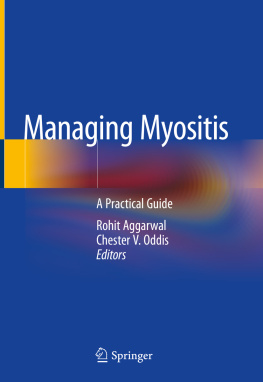Lawrence J. Kagen (editor) - The Inflammatory Myopathies
Here you can read online Lawrence J. Kagen (editor) - The Inflammatory Myopathies full text of the book (entire story) in english for free. Download pdf and epub, get meaning, cover and reviews about this ebook. year: 2009, publisher: Humana, genre: Romance novel. Description of the work, (preface) as well as reviews are available. Best literature library LitArk.com created for fans of good reading and offers a wide selection of genres:
Romance novel
Science fiction
Adventure
Detective
Science
History
Home and family
Prose
Art
Politics
Computer
Non-fiction
Religion
Business
Children
Humor
Choose a favorite category and find really read worthwhile books. Enjoy immersion in the world of imagination, feel the emotions of the characters or learn something new for yourself, make an fascinating discovery.
- Book:The Inflammatory Myopathies
- Author:
- Publisher:Humana
- Genre:
- Year:2009
- Rating:5 / 5
- Favourites:Add to favourites
- Your mark:
- 100
- 1
- 2
- 3
- 4
- 5
The Inflammatory Myopathies: summary, description and annotation
We offer to read an annotation, description, summary or preface (depends on what the author of the book "The Inflammatory Myopathies" wrote himself). If you haven't found the necessary information about the book — write in the comments, we will try to find it.
This book presents a comprehensive review of the inflammatory myopathies, including dermatomyositis, polymyositis, and inclusion body myositis. Representing the most up-to-date knowledge on this family of diseases, this book is the gold-standard in its field.
The Inflammatory Myopathies — read online for free the complete book (whole text) full work
Below is the text of the book, divided by pages. System saving the place of the last page read, allows you to conveniently read the book "The Inflammatory Myopathies" online for free, without having to search again every time where you left off. Put a bookmark, and you can go to the page where you finished reading at any time.
Font size:
Interval:
Bookmark:
Proximal musculature |
Most myopathies, including myositis syndromes and muscular dystrophy |
Distal musculature |
Inclusion body myositis |
Myotonic dystrophy |
Distal myopathies |
Neurogenic disorders (e.g., neuropathy, radiculopathy, myelopathy) |
Facial musculature |
Facioscapular humeral dystrophy |
Myasthenia gravis |
Myotonic dystrophy |
Mitochondrial myopathy (e.g., Kearns Sayres syndrome) |
Cranial nerve disorders and central nervous system conditions (e.g., Bells palsy, myasthenia gravis, cerebrovascular accident) |
Font size:
Interval:
Bookmark:
Similar books «The Inflammatory Myopathies»
Look at similar books to The Inflammatory Myopathies. We have selected literature similar in name and meaning in the hope of providing readers with more options to find new, interesting, not yet read works.
Discussion, reviews of the book The Inflammatory Myopathies and just readers' own opinions. Leave your comments, write what you think about the work, its meaning or the main characters. Specify what exactly you liked and what you didn't like, and why you think so.













